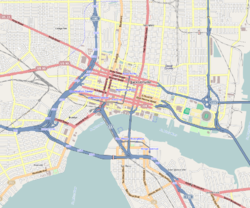History
The area was first settled in 1801, when Phillip Dell started a large 800-acre plantation there known as Dell's Bluff. Dell's Bluff changed hands several times before the American Civil War. After the war it was acquired by Miles Price, who sold the southern half of the property to be developed as the suburb of Riverside. The northern section he retained and developed himself as Brooklyn. [4]
It appears that Price gave Brooklyn its name, but it is not known why a former staunch Confederate would have chosen a name so associated with the New York borough of Brooklyn. Price's Brooklyn was initially a residential suburb, growing quickly with the establishment of a streetcar line. The area held a population of 1,000 and a few hundred homes and mansions. African-American former soldiers (known as Buffalo Soldiers) lived in the neighborhood, and one of their houses still stands, though in disrepair. [5] In 1887 Brooklyn and several other suburbs were annexed by Jacksonville. It remained primarily residential into the 20th century, but it eventually developed into a commercial and industrial area with the increasing use of the railway. In the 1950s, Interstate 95 over the Fuller Warren Bridge cut off the historically black neighborhood. [6] In the late 20th century, a number of commercial skyscrapers and other building were constructed along the river and Riverside Avenue. [4]
Subsequently, a rift emerged between the office-centered part of the neighborhood on the river and the traditional neighborhood further inland. As such, the city developed plans in the late 20th and early 21st century to reintroduce residential zoning and mixed-use development. [4] [7]
Gentrification is affecting the long-term residents of Brooklyn. [6] [8]
This page is based on this
Wikipedia article Text is available under the
CC BY-SA 4.0 license; additional terms may apply.
Images, videos and audio are available under their respective licenses.



